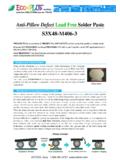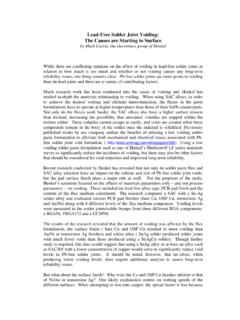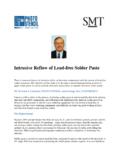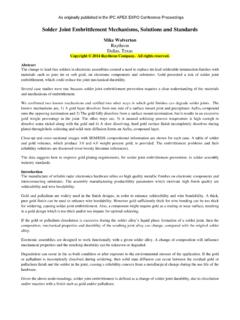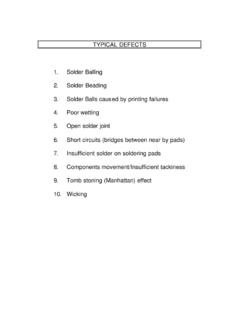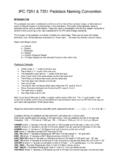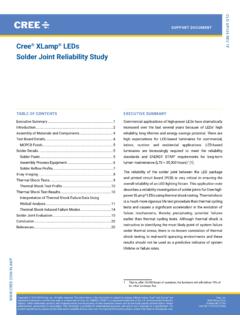Transcription of NanoStar & NanoFree 300 m Solder Bump Wafer …
1 Application ReportSBVA017 - February 20041 NanoStart & NanoFreet 300mm Solder Bump WaferChip-Scale Package ApplicationJim RossonHigh Performance Analog MAKE PackagingABSTRACTThe NanoStartWafer Chip-Scale Package (WCSP) is a family of bare die packagesdeveloped for applications that require the smallest possible package. WCSP provideselectrical interconnection via Solder spheres attached to the die and is aligned with JEDEC package standard MO 211[1]. NanoStar , with advanced materials engineering technology,has demonstrated excellent board level reliability that allows it to be used without the need forunderfill adhesives, unlike conventional Solder -bumped Flip Chip devices.
2 This advanceddesign allows standard, low-cost surface-mount technology (SMT) assembly processes tobe used successfully. This application guide provides the necessary design and reliabilityinformation to apply the NanoStar 300 m Solder bump .. Package Offerings and Nomenclature4 .. 2 Physical Description5 .. Package Characteristics5 .. NanoStar Package Dimensions6 .. Thermal Performance8 .. Board Level Reliability10 .. 3 Printed Circuit Board Assembly13 .. PCB Design Guidelines13 .. PCB Land Pattern Recommendations14 .. Solder Paste Stencil Design15.
3 Component Placement15 .. Reflow16 .. 4 Tape and Reel Information17 .. Material Specifications17 .. 5 Symbolization19 .. 6 Features and Benefits20 .. 7 Conclusion21 .. Acknowledgments21 .. References21 .. Trademarks are the property of their respective & NanoFreet 300mm Solder Bump Wafer Chip-Scale Package ApplicationList of FiguresFigure 1. NanoStartWCSP, SOT 23, & SC 70 Size Comparison3 .. Figure 2. NanoStar WCSP5 .. Figure 3. Direct Bump WCSP Construction Cross-Section5 .. Figure 4. RDL WCSP Construction Cross-Section6 .. Figure 5. YEB Package Dimensions7.
4 Figure 6. JEDEC 1S0P Thermal Performance Data Graph8 .. Figure 7. JEDEC 2S2P Thermal Performance Data Graph8 .. Figure 8. N25 5x5 Pin Array, Square, Daisy-Chain Test Die Diagram11 .. Figure 9. N12 3x4 Pin Array, x , Daisy-Chain Test Die Diagram11 .. Figure 10. 12-Site Thermal Cycle Test BLR Test Board11 .. Figure 11. N25 TCT Weibull Comparison of Ramp Rates and Materials12 .. Figure 12. Typical Tin-Lead BLR Solder Fatigue Crack13 .. Figure 13. Enlargement of Crack Area in Figure 1213 .. Figure 14. Typical Lead-Free BLR Solder Fatigue Crack13 .. Figure 15.
5 Enlargement of Crack Area in Figure 1413 .. Figure 16. Example of 5x5 Array Balanced Routing Pattern14 .. Figure 17. Recommended Solder Land Pattern Outline15 .. Figure 18. Recommended Reflow Profiles16 .. Figure 19. Pocket Tape Dimensions17 .. Figure 20. Pocket Tape Dimensions18 .. Figure 21. Carrier-Tape Cavity Quadrant Location for Pin 1, per EIA 481B19 .. List of TablesTable 1. NanoStart & NanoFreet 300 m Solder Bump Package Family Summary4.. Table 2. Simulated Thermal Resistance Data 9 .. Table 3. Board-Level Reliability Test Matrix10 .. Table 4. NanoStar Board Level Reliability Summary12.
6 Table 5. Recommended PCB Solder Land Pattern14 .. Table 6. Recommended Solder Stencil Pattern15 .. Table 7. Recommended Critical Reflow Parameters17 .. Table 8. Common Tape Dimensions by Designator18 .. Table 9. Reel Specifications18 .. Table 10. Device-Marking Guidelines 19 .. SBVA0173 NanoStart & NanoFreet 300mm Solder Bump Wafer Chip-Scale Package Application1 IntroductionIn today s mobile environment, there seems to be an insatiable market demand for the smallestand lightest possible electronic products with high reliability. Electronics manufacturers are de-signing smaller and smaller products with each generation and release.
7 Many different types ofpackages have been developed to meet this need. Popular package sizes such as MSOP,SOT 23, SC 70, and QFN outlines are quite large in comparison to a die size or Wafer -levelchip-scale package. (See Figure 1.) There are several names for die size packages, includingFlip Chip (FC), Wafer -Level Chip Scale Package (WLCSP), and Wafer Scale Package (WSP).Regardless of the package name, however, the benefits to a die size package are clear: thesmallest possible form factor for an integrated circuit silicon die is the die utilizes new advanced polymer technology materials to enhance the board-level reliability ofthe NanoStart300 m Solder ball packages.
8 Many suppliers of WCSP packages use relativelybrittle re-passivation polymeric materials. While these brittle materials work well for some ap-plications, they have been shown to have poorer performance for 300 m Solder sphere-bumpeddevices.[2] As a result of the new polymer technology available in the NanoStar package, TIcustomers do not have to experience premature device or reliability failures caused by brittle re-passivation and often seen in competitive 70 TopNanoStarBottomTopSOT 23 Figure 1. NanoStart WCSP, SOT 23, & SC 70 Size ComparisonThere are many challenges in interconnecting the micron-level world of silicon to enable bare dieuse in the millimeter-based world of SMT assembly.
9 The proper system design for a die sizepackage application is critical. NanoStar WCSP has been developed in 4 36 pin packages toenable high performance products to be as small as possible. A summary of the available pack-ages is provided in Section This package size not only enables smaller products, but alsoprovides improved electrical performance. The performance increase is a direct result of shorterinterconnections and, consequently, reduced parasitic losses due to interconnect & NanoFreet 300mm Solder Bump Wafer Chip-Scale Package ApplicationNanoStar WCSP adds other visible features, as well.
10 All NanoStar devices are laser-marked toprovide device identification and production lot tracking. Most analog NanoStar devices alsohave a protective backside surface coating to improve performance. This opaque coatingreduces the parametric shifts that can occur due to the light sensitivity of IC structures. Thecoating allows a WCSP to provide the same level of consistent performance obtained from amolded package application note provides the necessary information to apply NanoStar technology withmaximum success. The enclosed mechanical, electrical, and thermal package information, inaddition to printed circuit board (PCB) design recommendations and reliability data, are the cul-mination of another enabling technology developed for Texas Instruments Offerings and NomenclatureTable 1 shows the initial NanoStar WCSP package family lineup.










